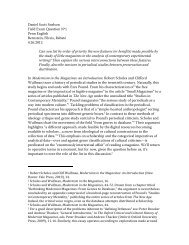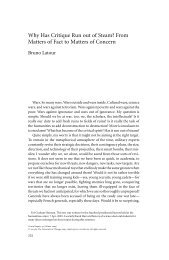The Exploit: A Theory of Networks - asounder
The Exploit: A Theory of Networks - asounder
The Exploit: A Theory of Networks - asounder
Create successful ePaper yourself
Turn your PDF publications into a flip-book with our unique Google optimized e-Paper software.
118 Edges<br />
regard, reduced to the human sciences. For Heidegger, this absence<br />
shows itself as a “missing ontological foundation,” on which “life itself,”<br />
and specifically human life, is understood, without recourse to the<br />
always - mystical and unstated “being <strong>of</strong> life” on which it is based.<br />
Our questions are: At what point does the difference between<br />
“being” and “life” implode? What would be the conditions for the<br />
nondistinction between “being” and “life”? Perhaps this is where the<br />
life sciences get hung up. <strong>The</strong>y are confronted with anomalies, anomalies<br />
that cross species barriers, that are at once “faceless” and yet<br />
“living”: single - celled organisms known as myxomycetes (such as<br />
the Physarum or Dictostylium), which, during their life cycles, may be<br />
either an amoeba, a motile cell with flagellum, or a plantlike structure<br />
giving <strong>of</strong>f spores. Or the famous limit case <strong>of</strong> the virus. Is it alive?<br />
It contains genetic material and is able to reproduce (or at least to<br />
replicate). It shows a high degree <strong>of</strong> genetic adaptability in its mutations<br />
and its ability to cross species boundaries. But it is not much<br />
more than a strand <strong>of</strong> RNA and a protein coating. <strong>The</strong>n, on the opposite<br />
side <strong>of</strong> the scale, there is the infamous case <strong>of</strong> Gaia . ..<br />
What Heidegger’s point makes clear is that the question <strong>of</strong> “life”<br />
has traditionally been separate from, but dependent on, an unquestioned<br />
notion <strong>of</strong> “being.” In a way, the example <strong>of</strong> network science<br />
presents us with the opposite case: a concept <strong>of</strong> “being” is arrived at<br />
by a privative definition <strong>of</strong> “life.” Network science, it would seem,<br />
assumes a minimally vitalistic aspect <strong>of</strong> networks, an assumption that<br />
informs its studies <strong>of</strong> networks <strong>of</strong> all types, networks that all share a<br />
being common to networks: “Whatever the identity and the nature<br />
<strong>of</strong> the nodes and links, for a mathematician they form the same animal:<br />
a graph or a network.” 21 Network science’s reliance on universality,<br />
ubiquity, and a mathematical model suggests that it is really a<br />
metaphysics <strong>of</strong> networks. It seeks a universal pattern that exists above<br />
and beyond the particulars <strong>of</strong> any given network. For this reason,<br />
network science can study AIDS, terrorism, and the Internet all as<br />
the same kind <strong>of</strong> being—a network.<br />
<strong>The</strong> philosophical impact <strong>of</strong> this view is that <strong>of</strong> network being, a<br />
Dasein specific to network phenomena. However, what it means specifically<br />
is confused. Does it mean the experience <strong>of</strong> being (in) a network,<br />
a new network phenomenology? Does it mean the existence <strong>of</strong>









